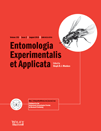Ver ítem
- xmlui.general.dspace_homeCentros Regionales y EEAsCentro Regional Buenos Aires NorteEEA Delta del ParanáArtículos científicosxmlui.ArtifactBrowser.ItemViewer.trail
- Inicio
- Centros Regionales y EEAs
- Centro Regional Buenos Aires Norte
- EEA Delta del Paraná
- Artículos científicos
- Ver ítem
Communication interference in sympatrically occurring moth species
Resumen
In moth species, females emit a species‐specific sex pheromone that is perceived over long distance by conspecific males. The species‐specificity in the chemical communication channel is achieved by a combination of unique components in specific ratios and sometimes also by interspecific behavioural antagonists to deter sympatrically occurring heterospecific males. In this study, we determined possible antagonistic effects in Helicoverpa gelotopoeon Dyar
[ver mas...]
In moth species, females emit a species‐specific sex pheromone that is perceived over long distance by conspecific males. The species‐specificity in the chemical communication channel is achieved by a combination of unique components in specific ratios and sometimes also by interspecific behavioural antagonists to deter sympatrically occurring heterospecific males. In this study, we determined possible antagonistic effects in Helicoverpa gelotopoeon Dyar (Lepidoptera: Noctuidae) males to the major sex pheromone component of sympatrically occurring heliothine moths, Z11‐16:Ald, as well as to the sex pheromone of the sympatrically occurring Heliothis virescens (Fabricius) (Lepidoptera: Noctuidae) (Z11‐16:Ald and Z9‐14:Ald). We also explored whether other co‐occurring species are attracted to these pheromone blends. Our field experiments showed that the addition of Z11‐16:Ald alone or in combination with Z9‐14:Ald inhibited trap catches of H. gelotopoeon males and that this inhibition depended on the concentration of these compounds. In addition, other moth species were attracted to the blends. Together, our results confirm the antagonistic effect of heterospecific sex pheromone compounds of H. virescens to H. gelotopoeon.
[Cerrar]

Autor
Juárez, María Laura;
Ruiz, María Josefina;
Fernandez, Patricia Carina;
Goane, Lucía;
Villagrán, María Elvira;
Arce, Osvaldo Ernesto Antonio;
Armiñana, Arturo;
Páez Jerez, Paula Gabriela;
de la Vega, Marcelo Horacio;
Vera, María Teresa;
Groot, A.T.;
Fuente
Entomologia Experimentalis et Applicata 158 (1) : 25-33 (January 2016)
Fecha
2016-01
Editorial
Wiley
ISSN
0013-8703
1570-7458
1570-7458
Formato
pdf
Tipo de documento
artículo
Palabras Claves
Derechos de acceso
Restringido
 Excepto donde se diga explicitamente, este item se publica bajo la siguiente descripción: Creative Commons Attribution-NonCommercial-ShareAlike 2.5 Unported (CC BY-NC-SA 2.5)
Excepto donde se diga explicitamente, este item se publica bajo la siguiente descripción: Creative Commons Attribution-NonCommercial-ShareAlike 2.5 Unported (CC BY-NC-SA 2.5)

